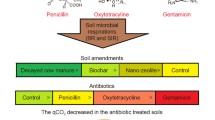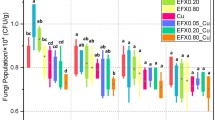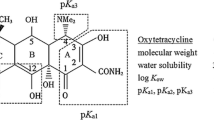Abstract
Sulfonamides and Cu are largely used feed additives in poultry farm. Subsequently, they are spread onto agricultural soils together with contaminated manure used as fertilizer. Both sulfonamides and Cu affect the soil microbial community. However, an interactive effect of sulfonamides and Cu on soil microorganisms is not well understood. Therefore, a short-time microcosm experiment was conducted to investigate the interaction of veterinary antibiotic sulfomethoxazole (SMX) and Cu on soil microbial structure composition and functions. To this end, selected concentrations of SMX (0, 5, and 50 mg kg−1) and Cu (0, 300, and 500 mg kg−1) were combined, respectively. Clear dose-dependent effects of SMX on microbial biomass and basal respiration were determined, and these effects were amplified in the presence of additional Cu. For activities of soil enzymes including β-glucosidase, urease, and protease, clear reducing effects were determined in soil samples containing 5 or 50 mg kg−1 of SMX, and the interaction of SMX and Cu was significant, particularly in soil samples containing 50 mg kg−1 SMX or 500 mg kg−1 Cu. SMX amendments, particularly in combination with Cu, significantly reduced amounts of the total, bacterial, and fungal phospholipid fatty acids (PLFAs) in soil. Moreover, the derived ratio of bacteria to fungi decreased significantly with incremental SMX and Cu, and principal component analysis of the PLFAs showed that soil microbial composition was significantly affected by SMX interacted with Cu at 500 mg kg−1. All of these results indicated that the interaction of SMX and Cu was synergistic to amplify the negative effect of SMX on soil microbial biomass, structural composition, and even the enzymatic function.


Similar content being viewed by others
References
Białk-Bielińska A, Kumirska J, Stepnowski P (2013) What do we know about the chronic and mixture toxicity of the residues of sulfonamides in the environment? In: Rash MN (ed) Organic pollutants—monitoring, risk and treatment. In Tech, Rijeka. doi:10.5772/53732
Chen YS, Zhang HB, Luo YM et al (2012a) Occurrence and assessment of veterinary antibiotics in swine manures: a case study in East China. Chinese Sci Bull 57:606–614
Chen YS, Zhang HB, Luo YM et al (2012b) Occurrence and dissipation of veterinary antibiotics in two typical swine waste-water treatment systems in east China. Environ Monit Assess 184:2205–2217
Cromwell GL (2013) Feed additives in swine diets. In: Chiba LI (ed) Sustainable swine nutrition. Blackwell Publishing Ltd., Oxford, pp 295–316
da Silva AK, Wells MJM, Morse AN et al (2013) Emerging pollutants—part I: occurrence, fate and transport. Water Environ Res 44:1978–2011
Demoling LA, Bååth E, Greve G et al (2009) Effects of sulfamethoxazole on soil microbial communities after adding substrate. Soil Biol Biochem 41:840–848
Ding C, He J (2010) Effect of antibiotics in the environment on microbial populations. Appl Microbiol Biotechnol 87:925–941
Fait G, Broos K, Zrna S et al (2006) Tolerance of nitrifying bacteria to copper and nickel. Environ Toxicol Chem 25:2000–2005
Federle TW (1986) Microbial distribution in soil: new techniques. In: Megusar F, Gantar M (eds) Perspectives in microbial ecology. Slovene Society for Microbiology, Ljubljana, pp 493–498
Frostegård A, Tunlid A, Bååth E (1993) Phospholipid fatty acid composition, biomass and activity of microbial communities from two soil types experimentally exposed to different heavy metals. Appl Environ Microbiol 59:3605–3617
Gao ML, Song WH, Zhou Q et al (2013) Interactive effect of oxytetracycline and lead on soil enzymatic activity and microbial biomass. Environ Toxicol Pharmacol 36(2):667–674
Gutiérrez IR, Watanabe N, Harter T et al (2010) Effect of sulfonamide antibiotics on microbial diversity and activity in a Californian Mollic Haploxeralf. J Soils Sedi 10:537–544
Hammesfahr U, Heuer H, Manzke B et al (2008) Impact of the antibiotic sulfadiazine and pig manure on the microbial community structure in agricultural soils. Soil Biol Biochem 40:1583–1591
Hammesfahr U, Kotzerke A, Lamshöft M et al (2011) Effects of sulfadiazine-contaminated fresh and stored manure on a soil microbial community. Eur J Soil Biol 47:61–68
Heinemeyer O, Insam H, Kaiser EA, Walenzik G (1989) Soil microbial biomass and respiration measurements: an automated technique based on infra-red gas analysis. Plant Soil 116:191–195
Hou J, Pan B, Niu X, Chen J, Xing B (2010) Sulfamethoxazole sorption by sediment fractions in comparison to pyrene and bisphenol A. Environ Pollut 158:2826–2832
Hu XG, Zhou QX, Luo Y (2010) Occurrence and source analysis of typical veterinary antibiotics in manure, soil, vegetables and groundwater from organic vegetable bases, northern China. Environ Pollut 158:2992–2998
Jechalke S, Heuer H, Sienmens J et al (2014) Fate and effects of veterinary antibiotics in soil. Trends microbial 22(9):536–545
Jörgensen RG (1995) Die quantitative bestimmung der mikrobiellen biomasse in Böden mit der Chloroform-fumigations-extraktions methode (Quantitative determination of microbial biomass in soils by use of the chloroform-fumigation-extraction method). Göttinger Bodenkdl Ber, pp,104, 229
Kandeler E, Gerber H (1988) Short-term assay of soil urease activity using colorimetric determination of ammonium. Biol Fertil Soils 6:68–72
Knapp CW, Dolfing J, Ehlert PAI et al (2010) Evidence of increasing antibiotic resistance gene abundances in archived soils since 1940. Environ Sci Technol 44:580–587
Kong WD, Zhu YG, Fu BJ, Marschner P, He JZ (2006) The veterinary antibiotic oxytetracycline and cu influence functional diversity of the soil microbial community. Environ Pollut 143:129–137
Kotzerke A, Sharma S, Schauss K et al (2008) Alterations in soil microbial activity and N-transformation processes due to sulfadiazine loads in pig-manure. Environ Pollut 153(2):315–322
Kumar RR, Park BJ, Cho JY (2013) Application and environmental risks of livestock manure. J Korean Soc Appl Biolog Chem 56(5):497–503
Li WC (2014) Occurrence, sources, and fate of pharmaceuticals in aquatic environment and soil. Environ Pollut 187:193–201
Liu F, Ying GG, Tao R et al (2009) Effects of six selected antibiotics on plant growth and soil microbial and enzymatic activities. Environ Pollut 157:1636–1642
Liu F, Sh WJ, Ying GG et al (2012) Changes in functional diversity of soil microbial community with addition of antibiotics sulfamethoxazole and chlortetracycline. App Microbiol Biotechnol 95(6):1615–1623
Lopes C, Herva M, Franco-Uria A et al (2011) Inventory of heavy metal content in organic waste applied as fertilizer in agriculture: evaluating the risk of transfer into the food chain. Environ Sci Pollut Res 18:918–939
Lu RK (ed) (1999) Analytical methods of soil agrochemistry (in Chinese). China Agricultural Science and Technology Press, Beijing
Martins VV, Zanetti MOB, Pitondo-Silva A, Stehling EG (2014) Aquatic environments polluted with antibiotics and heavy metals: a human health hazard. Environ Sci Pollut Res 21:5873–5878
Niu L, Yang F, Xu C et al (2013) Status of metal accumulation in farmland soils across China: from distribution to risk assessment. Environ Pollut 176:55–62
Reichel R, Radl V, Rosendahl I et al (2014) Soil microbial community responses to antibiotic-contaminated manure under different soil moisture regimes. Appl Microbiol Biotechnol 98(14):6487–6495
Rusk JA, Hamon RE, Stevens DP et al (2004) Adaptation of soil biological nitrification to heavy metals. Environ Sci Technol 38(11):3092–3097
Schauss K, Focks A, Leininger S et al (2009) Dynamics and functional relevance of ammonia-oxidizing archaea in two agricultural soils. Environ Microbiol 11:446–456
Schinner F, Öhlinger R, Kandeler E, Margesin R (1993) Bodenbiologische Arbeitsmethoden. Springer-Verlag, Berlin, p 389
Vance ED, Brookes PC, Jenkinsen DS (1987) An extraction method for measuring soil microbial biomass C. Soil Biol Biochem 19:703–707
Warman PR (1980) The effect of amprolium and aureomycin on the nitrification of poultry manure-amended soil. Soil Sci Soc Am J 44:1333–1334
Wu L, Pan X, Chen L et al (2013) Occurrence and distribution of heavy metals and tetracyclines in agricultural soils after typical land use change in east China. Environ Sci Pollut Res 20:8342–8354
Xiong X, Li Y, Li W et al (2010) Copper content in animal manures and potential risk of soil copper pollution with animal manure use in agriculture. Resour Conserv Recyl 54:985–990
Yu ZY, Yin DQ, Deng HP (2015) The combinational effects between sulfonamides and metals on nematode Caenorhabditis elegans. Ecotoxicol Environl Saf 111:66–71
Zhang HB, LuoYM WLH, Huang YJ, Chris P (2014) Residues and potential ecological risks of veterinary antibiotics in manures and composts associated with protected vegetable farming. Environ Sci Poll Res. doi:10.1007/s11356-014-3731-9
Acknowledgments
The study was supported by the National Natural Science Foundation of China (NSFC) (No. 41001145), Projects of International Cooperation and Exchanges NSFC (41210104050), the international visiting project of Young Teachers in universities of Shandong Province, China, and the Foundation of Shandong University of Technology (No. 4072).
Author information
Authors and Affiliations
Corresponding author
Additional information
Responsible editor: Zhihong Xu
Rights and permissions
About this article
Cite this article
Liu, A., Cao, H., Yang, Y. et al. Combinational effects of sulfomethoxazole and copper on soil microbial community and function. Environ Sci Pollut Res 23, 4235–4241 (2016). https://doi.org/10.1007/s11356-015-4892-x
Received:
Accepted:
Published:
Issue Date:
DOI: https://doi.org/10.1007/s11356-015-4892-x




